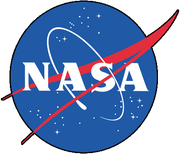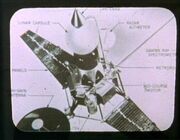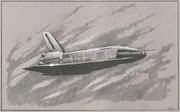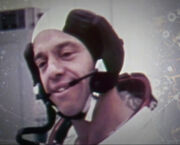m (lk fix) |
m (Robot: Automated text replacement (-== Background == +== Background information ==)) Tag: apiedit |
||
| (7 intermediate revisions by 6 users not shown) | |||
| Line 1: | Line 1: | ||
[[File:NASA_logo.png|thumb|NASA insignia]] |
[[File:NASA_logo.png|thumb|NASA insignia]] |
||
| − | '''National Aeronautics and Space Administration''' ('''NASA''') was the designation for an early [[Human]] [[space]] exploration agency created by the |
+ | '''National Aeronautics and Space Administration''' ('''NASA''') was the designation for an early [[Human]] [[space]] exploration agency created by the [[Earth]] [[Country|nation]] [[United States of America]] in [[1958]]. ({{film|1}}) |
NASA oversaw the launch of a vast majority of the major spaceflight milestones of the [[20th century|20th]] and [[21st century|21st centuries]]. |
NASA oversaw the launch of a vast majority of the major spaceflight milestones of the [[20th century|20th]] and [[21st century|21st centuries]]. |
||
| Line 6: | Line 6: | ||
==History== |
==History== |
||
*'''[[1958]]''' - NASA is founded |
*'''[[1958]]''' - NASA is founded |
||
| − | *'''[[1959]]''' - The |
+ | *'''[[1959]]''' - The [[Ranger|Ranger program]] starts ({{TOS|The Cage}}) |
*'''[[1960]]''' - The [[probe]] ''[[Pioneer 5]]'' is launched ({{TOS|The Cage}}) |
*'''[[1960]]''' - The [[probe]] ''[[Pioneer 5]]'' is launched ({{TOS|The Cage}}) |
||
*'''[[1961]]''' - [[Alan Shepard]] is the first American [[astronaut]] in space |
*'''[[1961]]''' - [[Alan Shepard]] is the first American [[astronaut]] in space |
||
| − | [[File:Ranger 5.jpg|thumb|Diagram of |
+ | [[File:Ranger 5.jpg|thumb|Diagram of ''Ranger 5'']] |
*'''[[1962]]''' - [[John Glenn]] is the first American to complete an [[orbit]] of the Earth ({{VOY|One Small Step}}) |
*'''[[1962]]''' - [[John Glenn]] is the first American to complete an [[orbit]] of the Earth ({{VOY|One Small Step}}) |
||
*'''1962''' - The probe ''[[Mariner 2]]'' is launched ({{TOS|The Cage}}) |
*'''1962''' - The probe ''[[Mariner 2]]'' is launched ({{TOS|The Cage}}) |
||
*'''1962''' - The probe ''[[Ranger 5]]'' is launched ({{TOS|The Cage}}) |
*'''1962''' - The probe ''[[Ranger 5]]'' is launched ({{TOS|The Cage}}) |
||
*'''[[1968]]''' - A [[nuclear weapons platform]] was launched from [[McKinley Rocket Base]] The warhead apparently armed itself, but exploded 104 miles from Earth's surface ({{TOS|Assignment: Earth}}) |
*'''[[1968]]''' - A [[nuclear weapons platform]] was launched from [[McKinley Rocket Base]] The warhead apparently armed itself, but exploded 104 miles from Earth's surface ({{TOS|Assignment: Earth}}) |
||
| − | * |
+ | *'''[[1969]]''' - The ''[[Apollo 11]]'' spacecraft lands on the [[Luna|Moon]], recording Humanity's first steps on another celestial body; [[Neil Armstrong]] and [[Buzz Aldrin]] are the first Humans to step on the Moon ({{ENT|Carbon Creek|First Flight}}; {{TOS|Tomorrow is Yesterday}}; {{VOY|Threshold|One Small Step|Nightingale}}) |
* '''[[1971]]''' - [[Alan Shepard]] [[commanding officer|commands]] ''[[Apollo 14]]'' mission (''[[Star Trek: Enterprise]]'' opening credits) |
* '''[[1971]]''' - [[Alan Shepard]] [[commanding officer|commands]] ''[[Apollo 14]]'' mission (''[[Star Trek: Enterprise]]'' opening credits) |
||
* '''[[1972]]''' - The probe ''[[Pioneer 10]]'' is launched ({{film|5}}) |
* '''[[1972]]''' - The probe ''[[Pioneer 10]]'' is launched ({{film|5}}) |
||
| − | * '''[[1973]]''' - The first American [[space station]] ''[[Skylab]]'' is launched into Earth orbit ({{film|8}}; {{ENT|First Flight}}) ''[[Pioneer 11]]'' is launched |
+ | * '''[[1973]]''' - The first American [[space station]] ''[[Skylab]]'' is launched into Earth orbit ({{film|8}}; {{ENT|First Flight}}) ''[[Pioneer 11]]'' is launched ({{TNG|Loud As A Whisper}}) |
[[File:Enterprise OV-101.jpg|thumb|[[space shuttle]]]] |
[[File:Enterprise OV-101.jpg|thumb|[[space shuttle]]]] |
||
| − | * '''[[1976]]''' - The [[space shuttle]] program starts by conducting the first tests with the prototype, [[Enterprise (OV-101)|''Enterprise OV-101 |
+ | * '''[[1976]]''' - The [[space shuttle]] program starts by conducting the first tests with the prototype, [[Enterprise (OV-101)|''Enterprise'' OV-101]] (''[[Star Trek: Enterprise]]'' opening credits; {{film|1}}) |
| − | * '''[[1979]]''' - ''Pioneer 11'' becomes the first Human spacecraft to visit Saturn. This success is the culmination of 22 years of work to visit and survey those planets that had been seen by Humans prior to the invention of the [[telescope]] |
+ | * '''[[1979]]''' - ''Pioneer 11'' becomes the first Human spacecraft to visit Saturn. This success is the culmination of 22 years of work to visit and survey those planets that had been seen by Humans prior to the invention of the [[telescope]] ({{TNG|Loud As A Whisper}}, ''[[okudagram]]'') |
| − | * '''[[1986]]''' - The [[Space shuttle missions#STS-51L|space shuttle ''Challenger OV-099 |
+ | * '''[[1986]]''' - The [[Space shuttle missions#STS-51L|space shuttle ''Challenger'' OV-099]] explodes 78 seconds after liftoff, [[death|killing]] seven astronauts (dedication from {{film|4}}) |
| − | * '''[[1996]]''' - [[Scientist]]s from NASA find the first microscopic evidence of past [[lifeform|life]] on [[Mars]] |
+ | * '''[[1996]]''' - [[Scientist]]s from NASA find the first microscopic evidence of past [[lifeform|life]] on [[Mars]] ({{VOY|Future's End}}) |
| − | * '''[[1997]]''' - [[Sojourner]], the first rover vehicle launched by NASA lands on Mars ({{ENT|Terra Prime}}) |
+ | * '''[[1997]]''' - ''[[Sojourner]]'', the first rover vehicle launched by NASA lands on Mars ({{ENT|Terra Prime}}) |
| − | |||
[[File:ISS model, ENT opening credits.jpg|thumb|[[International Space Station|ISS]]]] |
[[File:ISS model, ENT opening credits.jpg|thumb|[[International Space Station|ISS]]]] |
||
* '''[[1990s]] to ?''' - NASA participates in the [[International Space Station]] project (''[[Star Trek: Enterprise]]'' opening credits) |
* '''[[1990s]] to ?''' - NASA participates in the [[International Space Station]] project (''[[Star Trek: Enterprise]]'' opening credits) |
||
* '''[[1999]]''' - The probe ''[[Voyager 6]]'' is launched ({{film|1}}; ''[[Star Trek Chronology]]'') |
* '''[[1999]]''' - The probe ''[[Voyager 6]]'' is launched ({{film|1}}; ''[[Star Trek Chronology]]'') |
||
| − | * '''[[2002]]''' - The probe |
+ | * '''[[2002]]''' - The probe [[Nomad|''Nomad'' MK-15c]], constructed by [[Jackson Roykirk]], is launched ({{TOS|The Changeling}}; {{ENT|Dead Stop}}) |
* '''[[21st century|Early 21st century]]''' - The space shuttle [[OV-165]] is launched (''[[Star Trek: Enterprise]]'' opening credits) |
* '''[[21st century|Early 21st century]]''' - The space shuttle [[OV-165]] is launched (''[[Star Trek: Enterprise]]'' opening credits) |
||
* '''Early 21st century''' - The [[Earth-Saturn probe]] expedition is conducted by [[Colonel]] [[Shaun Geoffrey Christopher]] and includes [[Fontana]] and [[O'Herlihy (astronaut)|O'Herlihy]] ({{ENT|First Flight}}; {{TOS|Tomorrow is Yesterday}}) |
* '''Early 21st century''' - The [[Earth-Saturn probe]] expedition is conducted by [[Colonel]] [[Shaun Geoffrey Christopher]] and includes [[Fontana]] and [[O'Herlihy (astronaut)|O'Herlihy]] ({{ENT|First Flight}}; {{TOS|Tomorrow is Yesterday}}) |
||
| − | * '''Early 21st century''' - NASA collaborates with other space agencies in the [[International Space Agency]], in particular during the ''[[Ares IV]]'' mission to Mars in [[2032]] (conducted by [[John Kelly]], [[Rose Kumagawa]] and [[Andrei Novakovich]]) ({{VOY|One Small Step}}) |
+ | * '''Early 21st century''' - NASA collaborates with other space agencies in the [[International Space Agency]], in particular during the ''[[Ares IV]]'' mission to Mars in [[2032]] (conducted by [[John Kelly]], [[Rose Kumagawa]], and [[Andrei Novakovich]]) ({{VOY|One Small Step}}) |
| ⚫ | |||
| − | |||
| + | *'''[[2037]]''' - The [[spaceship]] ''[[Charybdis]]'' is launched as the third attempt to explore beyond the [[Sol system]]; the [[crew]] include [[Colonel]] [[Stephen G. Richey]], [[Evans (NASA)|Evans]], [[Schmitt]], and [[Cernan]] ({{TNG|The Royale}}) |
||
| ⚫ | |||
| − | *'''[[ |
+ | * '''[[2038]]''' - NASA loses contact with the ''Charybdis'' following a failure in the [[ship]]'s telemetry system. It was later learned that the ''Charybdis'' was contaminated by an [[alien]] lifeform which infected and killed all personnel except mission commander [[Stephen G. Richey]] ({{TNG|The Royale}}) |
| − | * '''[[2038]]''' - NASA loses contact with the ''[[Charybdis]]'' following a failure in the [[ship]]'s telemetry system. It was later learned that the ''Charybdis'' was contaminated by an [[alien]] lifeform which infected and killed all personnel except mission commander [[Stephen G. Richey]]. ({{TNG|The Royale}}) |
||
| − | |||
{{bginfo|A display graphic not seen on screen in the episode but featured in ''[[Star Trek: The Next Generation - The Continuing Mission]]'' shows that the spaceship ''[[Jacob]]'' was subsequently launched to conduct a follow up mission on locating the ''Charybdis''|Many of the dates in this list are derived from real-world information. It is possible that NASA merged later on with the [[Russia]]n, [[Japan]]ese, and [[Europe]]an space agencies along with the emergence of the [[United Earth Space Probe Agency]].|The similarity of the [[Starfleet]] logo/crest to that of NASA design (not to mention the similarity of the mottos) suggests that the NASA component had an influential role.}} |
{{bginfo|A display graphic not seen on screen in the episode but featured in ''[[Star Trek: The Next Generation - The Continuing Mission]]'' shows that the spaceship ''[[Jacob]]'' was subsequently launched to conduct a follow up mission on locating the ''Charybdis''|Many of the dates in this list are derived from real-world information. It is possible that NASA merged later on with the [[Russia]]n, [[Japan]]ese, and [[Europe]]an space agencies along with the emergence of the [[United Earth Space Probe Agency]].|The similarity of the [[Starfleet]] logo/crest to that of NASA design (not to mention the similarity of the mottos) suggests that the NASA component had an influential role.}} |
||
| Line 65: | Line 62: | ||
*[[Mercury-Redstone Launch Vehicle]] |
*[[Mercury-Redstone Launch Vehicle]] |
||
| − | == Background == |
+ | == Background information == |
| + | During the 1970s, [[Nichelle Nichols]] worked for NASA, helping recruit women and ethnic minority astronauts, including the first female American astroanut {{w|Sally Ride}} and 2010s NASA administrator {{w|Charles Bolden}}. [http://edition.cnn.com/2014/08/04/showbiz/star-trek-legend/index.html] |
||
| + | |||
The National Aeronautics and Space Administration received "grateful acknowledgment" in the [[Credits for Star Trek: The Motion Picture#Closing credits|closing credits]] of {{film|1}}, as well as the [[Credits for Star Trek II: The Wrath of Khan#Closing credits|closing credits]] of {{film|2}}. |
The National Aeronautics and Space Administration received "grateful acknowledgment" in the [[Credits for Star Trek: The Motion Picture#Closing credits|closing credits]] of {{film|1}}, as well as the [[Credits for Star Trek II: The Wrath of Khan#Closing credits|closing credits]] of {{film|2}}. |
||
| Line 75: | Line 74: | ||
== External links == |
== External links == |
||
| − | * [http://www.nasa.gov |
+ | * [http://www.nasa.gov NASA.gov] - official website |
* {{Wikipedia|NASA}} |
* {{Wikipedia|NASA}} |
||
* {{eas|database/nasa_references.htm|NASA References in ''Star Trek''|external}} |
* {{eas|database/nasa_references.htm|NASA References in ''Star Trek''|external}} |
||
| Line 83: | Line 82: | ||
[[it:National Aeronautics and Space Administration]] |
[[it:National Aeronautics and Space Administration]] |
||
[[nl:NASA]] |
[[nl:NASA]] |
||
| + | [[ru:НАСА]] |
||
[[Category:Earth agencies]] |
[[Category:Earth agencies]] |
||
Revision as of 15:29, 24 October 2015

NASA insignia
National Aeronautics and Space Administration (NASA) was the designation for an early Human space exploration agency created by the Earth nation United States of America in 1958. (Star Trek: The Motion Picture)
NASA oversaw the launch of a vast majority of the major spaceflight milestones of the 20th and 21st centuries.
History
- 1958 - NASA is founded
- 1959 - The Ranger program starts (TOS: "The Cage")
- 1960 - The probe Pioneer 5 is launched (TOS: "The Cage")
- 1961 - Alan Shepard is the first American astronaut in space

Diagram of Ranger 5
- 1962 - John Glenn is the first American to complete an orbit of the Earth (VOY: "One Small Step")
- 1962 - The probe Mariner 2 is launched (TOS: "The Cage")
- 1962 - The probe Ranger 5 is launched (TOS: "The Cage")
- 1968 - A nuclear weapons platform was launched from McKinley Rocket Base The warhead apparently armed itself, but exploded 104 miles from Earth's surface (TOS: "Assignment: Earth")
- 1969 - The Apollo 11 spacecraft lands on the Moon, recording Humanity's first steps on another celestial body; Neil Armstrong and Buzz Aldrin are the first Humans to step on the Moon (ENT: "Carbon Creek", "First Flight"; TOS: "Tomorrow is Yesterday"; VOY: "Threshold", "One Small Step", "Nightingale")
- 1971 - Alan Shepard commands Apollo 14 mission (Star Trek: Enterprise opening credits)
- 1972 - The probe Pioneer 10 is launched (Star Trek V: The Final Frontier)
- 1973 - The first American space station Skylab is launched into Earth orbit (Star Trek: First Contact; ENT: "First Flight") Pioneer 11 is launched (TNG: "Loud As A Whisper")

- 1976 - The space shuttle program starts by conducting the first tests with the prototype, Enterprise OV-101 (Star Trek: Enterprise opening credits; Star Trek: The Motion Picture)
- 1979 - Pioneer 11 becomes the first Human spacecraft to visit Saturn. This success is the culmination of 22 years of work to visit and survey those planets that had been seen by Humans prior to the invention of the telescope (TNG: "Loud As A Whisper", okudagram)
- 1986 - The space shuttle Challenger OV-099 explodes 78 seconds after liftoff, killing seven astronauts (dedication from Star Trek IV: The Voyage Home)
- 1996 - Scientists from NASA find the first microscopic evidence of past life on Mars (VOY: "Future's End")
- 1997 - Sojourner, the first rover vehicle launched by NASA lands on Mars (ENT: "Terra Prime")

- 1990s to ? - NASA participates in the International Space Station project (Star Trek: Enterprise opening credits)
- 1999 - The probe Voyager 6 is launched (Star Trek: The Motion Picture; Star Trek Chronology)
- 2002 - The probe Nomad MK-15c, constructed by Jackson Roykirk, is launched (TOS: "The Changeling"; ENT: "Dead Stop")
- Early 21st century - The space shuttle OV-165 is launched (Star Trek: Enterprise opening credits)
- Early 21st century - The Earth-Saturn probe expedition is conducted by Colonel Shaun Geoffrey Christopher and includes Fontana and O'Herlihy (ENT: "First Flight"; TOS: "Tomorrow is Yesterday")
- Early 21st century - NASA collaborates with other space agencies in the International Space Agency, in particular during the Ares IV mission to Mars in 2032 (conducted by John Kelly, Rose Kumagawa, and Andrei Novakovich) (VOY: "One Small Step")
NASA Logotype, ca. 2037 on Charybdis debris
- 2037 - The spaceship Charybdis is launched as the third attempt to explore beyond the Sol system; the crew include Colonel Stephen G. Richey, Evans, Schmitt, and Cernan (TNG: "The Royale")
- 2038 - NASA loses contact with the Charybdis following a failure in the ship's telemetry system. It was later learned that the Charybdis was contaminated by an alien lifeform which infected and killed all personnel except mission commander Stephen G. Richey (TNG: "The Royale")
Personnel
Astronauts

Alan Shepard in 1971
- Aldrin, Buzz
- Armstrong, Neil
- Cernan
- Conrad, Pete
- Evans
- Glenn, John
- Richey, Stephen G.
- Shepard, Alan
- Schmitt
Others
- Moss, Gerald (media relations department)
- O'Donnell, Shannon (aerospace engineer)
- Roykirk, Jackson (scientist)
Vehicles and rockets
Background information
During the 1970s, Nichelle Nichols worked for NASA, helping recruit women and ethnic minority astronauts, including the first female American astroanut Sally Ride and 2010s NASA administrator Charles Bolden. [1]
The National Aeronautics and Space Administration received "grateful acknowledgment" in the closing credits of Star Trek: The Motion Picture, as well as the closing credits of Star Trek II: The Wrath of Khan.
To achieve a more realistic and gritty look for Deep Space 9, the Star Trek: Deep Space Nine production team looked at NASA photographs of the space shuttles and other space vehicles. (Star Trek - Where No One Has Gone Before)
For the rendering of Earth seen in DS9: "Past Tense, Part I" and DS9: "Past Tense, Part II", David Takemura used an eight-by-ten NASA transparency of the planet to create the footage. (Star Trek: Deep Space Nine Companion)
Three "real" NASA astronauts have appeared in Trek productions – Mae Jemison (the first African-American woman in space) played Lt. Palmer in TNG: "Second Chances", while E. Michael Fincke and Terry Virts (though Virts was uncredited) appeared together as Lt. M. Fincke and Ens. T. Virts, respectively, in the Enterprise finale "These Are the Voyages...".
External links
- NASA.gov - official website
- NASA at Wikipedia
- NASA References in Star Trek at Ex Astris Scientia
